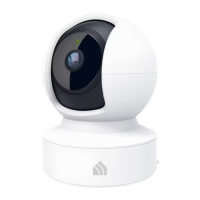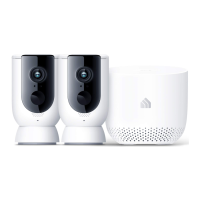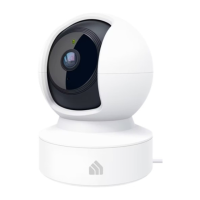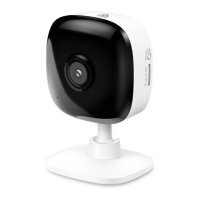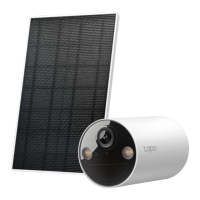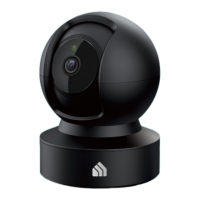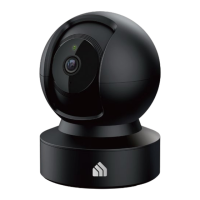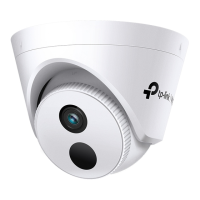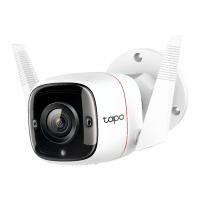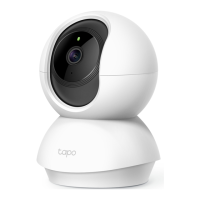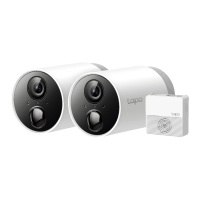Do you have a question about the TP-Link KC105 and is the answer not in the manual?
Explains guide conventions like teal text for key info.
Provides links to product specs, support, and FAQs.
Details the meaning of different LED color states.
Explains how to use the reset button for setup or factory reset.
Guide to download the app and sign in or create an account.
Steps to begin adding a camera within the Kasa app.
Guidance on placing and mounting the camera, including wall installation.
Overview of the Kasa app's home screen for device management.
How to quickly control camera power and enter Privacy Mode.
Explains continuous recording capabilities for never missing events.
Steps to activate/deactivate continuous recording and check storage.
How to view previously recorded footage through the app.
Controls camera power, enabling privacy features when off.
Guide to rename your camera for easier identification.
Configuring detection sensitivity for motion and sound events.
Option to enable or disable sound recording during video capture.
Setting up activity notifications and limiting their frequency.
Creating custom areas for motion detection alerts.
Choosing the desired video quality for recordings.
How to change the video feed orientation (e.g., upside down).
Settings for automatic, off, or always-on night vision.
Option to turn the camera's status LED on or off.
Links to guides for wall-mounting and 24/7 recording.
Steps to reset the camera by removing it from the Kasa account.
Alternative method to reset the camera through device settings.
How to set up automations triggered by camera motion detection.
Example of triggering other Kasa devices based on motion detection.
Defining specific time windows for smart actions to run.
Optionally setting timers for actions to turn off automatically.
Giving a descriptive name to created smart actions for easy identification.
Using Kasa Spot with Amazon Alexa and Google Assistant.
Step-by-step guide to link Kasa with Amazon Alexa.
Finalizing the account linking process for Alexa control.
Guide to connect Kasa devices with Google Home.
Information regarding RF exposure limits and compliance.
States compliance with EU directives for the device.
Details compliance requirements for Canada.
Information on restricted materials used in the product.
Important guidelines for safe operation and handling of the device.
Explains symbols like DC voltage, indoor use, and recycling.
Explains guide conventions like teal text for key info.
Provides links to product specs, support, and FAQs.
Details the meaning of different LED color states.
Explains how to use the reset button for setup or factory reset.
Guide to download the app and sign in or create an account.
Steps to begin adding a camera within the Kasa app.
Guidance on placing and mounting the camera, including wall installation.
Overview of the Kasa app's home screen for device management.
How to quickly control camera power and enter Privacy Mode.
Explains continuous recording capabilities for never missing events.
Steps to activate/deactivate continuous recording and check storage.
How to view previously recorded footage through the app.
Controls camera power, enabling privacy features when off.
Guide to rename your camera for easier identification.
Configuring detection sensitivity for motion and sound events.
Option to enable or disable sound recording during video capture.
Setting up activity notifications and limiting their frequency.
Creating custom areas for motion detection alerts.
Choosing the desired video quality for recordings.
How to change the video feed orientation (e.g., upside down).
Settings for automatic, off, or always-on night vision.
Option to turn the camera's status LED on or off.
Links to guides for wall-mounting and 24/7 recording.
Steps to reset the camera by removing it from the Kasa account.
Alternative method to reset the camera through device settings.
How to set up automations triggered by camera motion detection.
Example of triggering other Kasa devices based on motion detection.
Defining specific time windows for smart actions to run.
Optionally setting timers for actions to turn off automatically.
Giving a descriptive name to created smart actions for easy identification.
Using Kasa Spot with Amazon Alexa and Google Assistant.
Step-by-step guide to link Kasa with Amazon Alexa.
Finalizing the account linking process for Alexa control.
Guide to connect Kasa devices with Google Home.
Information regarding RF exposure limits and compliance.
States compliance with EU directives for the device.
Details compliance requirements for Canada.
Information on restricted materials used in the product.
Important guidelines for safe operation and handling of the device.
Explains symbols like DC voltage, indoor use, and recycling.
| Wi-Fi | Yes |
|---|---|
| Ethernet LAN | No |
| Wi-Fi standards | 802.11b, 802.11g, Wi-Fi 4 (802.11n) |
| Networking standards | IEEE 802.11b, IEEE 802.11g, IEEE 802.11n |
| Wi-Fi data rate (max) | 72 Mbit/s |
| Type | IP security camera |
| Certification | FCC, CE, RCM, RoHS |
| Operating frequency | 2400 MHz |
| Placement supported | Indoor |
| Connectivity technology | Wireless |
| Compatible memory cards | MicroSD (TransFlash) |
| Maximum memory card size | 128 GB |
| Sustainability certificates | RoHS |
| Form factor | Cube |
| Mounting type | Desk |
| Product color | Black, White |
| LED indicators | System |
| Minimum illumination | - lx |
| Field of view (FOV) angle | 130 ° |
| AC input voltage | 100 - 240 V |
| DC output current | 1 A |
| DC output voltage | 5 |
| Power source type | AC, DC |
| AC input frequency | 50 - 60 Hz |
| Sensor type | - |
| Number of sensors | 1 |
| Optical sensor size | 1/2.9 \ |
| Fixed focal length | 3.3 mm |
| Maximum aperture number | 2 |
| LED type | IR |
| Infra-red wavelength | 850 nm |
| Night vision distance | 9 m |
| Cables included | USB |
| Total megapixels | - MP |
| Maximum resolution | 1920 x 1080 pixels |
| Supported video modes | 1080p |
| Video compression formats | H.264 |
| Audio system | 2-way |
| Security algorithms | WEP, WPA, WPA2-PSK |
| Storage temperature (T-T) | -20 - 70 °C |
| Operating temperature (T-T) | 0 - 40 °C |
| Storage relative humidity (H-H) | 5 - 90 % |
| Operating relative humidity (H-H) | 10 - 90 % |
| Mobile operating systems supported | Android 5.0, Android 5.1, Android 6.0, Android 7.0, Android 7.1, Android 7.1.2, Android 8.0, Android 9.0, iOS 10.0, iOS 11.0, iOS 11.4, iOS 12, iOS 13 |
| Harmonized System (HS) code | 85258900 |
| Depth | 49.6 mm |
|---|---|
| Width | 59 mm |
| Height | 88.6 mm |
